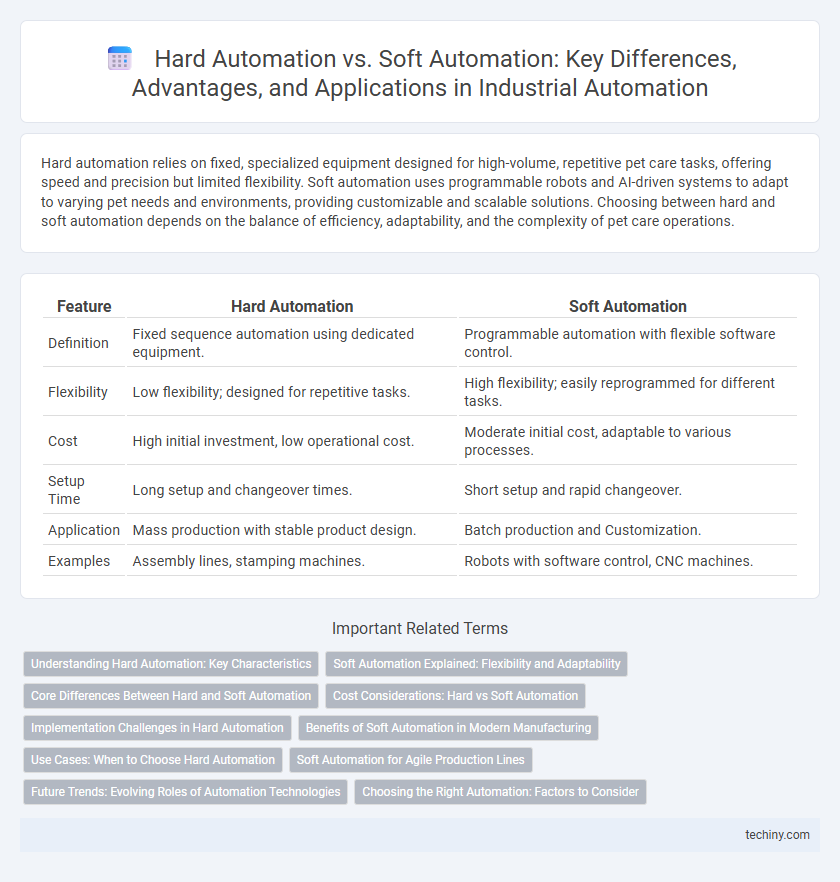Hard automation relies on fixed, specialized equipment designed for high-volume, repetitive pet care tasks, offering speed and precision but limited flexibility. Soft automation uses programmable robots and AI-driven systems to adapt to varying pet needs and environments, providing customizable and scalable solutions. Choosing between hard and soft automation depends on the balance of efficiency, adaptability, and the complexity of pet care operations.
Table of Comparison
| Feature | Hard Automation | Soft Automation |
|---|---|---|
| Definition | Fixed sequence automation using dedicated equipment. | Programmable automation with flexible software control. |
| Flexibility | Low flexibility; designed for repetitive tasks. | High flexibility; easily reprogrammed for different tasks. |
| Cost | High initial investment, low operational cost. | Moderate initial cost, adaptable to various processes. |
| Setup Time | Long setup and changeover times. | Short setup and rapid changeover. |
| Application | Mass production with stable product design. | Batch production and Customization. |
| Examples | Assembly lines, stamping machines. | Robots with software control, CNC machines. |
Understanding Hard Automation: Key Characteristics
Hard automation involves fixed, specialized equipment designed for high-volume production of standardized products, emphasizing rigidity and repeatability. It utilizes dedicated machines and tooling that perform specific tasks with minimal flexibility, leading to low adaptability for product variation. Key characteristics include high initial investment, long setup times, and superior efficiency in continuous, repetitive manufacturing processes.
Soft Automation Explained: Flexibility and Adaptability
Soft automation offers enhanced flexibility and adaptability compared to hard automation, enabling machines to perform diverse tasks through programmable controls and software adjustments. This type of automation leverages advanced sensors, artificial intelligence, and machine learning to quickly adapt to new processes and product variations without extensive retooling. Industries benefit from reduced downtime and increased efficiency by implementing soft automation solutions that support dynamic production environments.
Core Differences Between Hard and Soft Automation
Hard automation employs fixed, specialized equipment designed for high-volume, repetitive tasks with minimal flexibility, while soft automation uses programmable control systems enabling adaptability for various product types and production changes. Hard automation excels in industries requiring consistent output, such as automotive manufacturing, whereas soft automation suits environments demanding frequent adjustments, like electronics assembly. The core difference lies in hard automation's rigidity and efficiency versus soft automation's versatility and programmability.
Cost Considerations: Hard vs Soft Automation
Hard automation involves high initial investment costs due to specialized machinery and tooling designed for specific tasks, making it cost-effective only for large-scale, repetitive production runs. Soft automation utilizes programmable controllers and flexible equipment, allowing lower upfront expenditure and adaptability for varied processes, which suits smaller batch production and reduces changeover costs. The ongoing maintenance and reprogramming expenses tend to be lower in hard automation but are offset by its inflexibility, whereas soft automation requires continuous software updates but saves on physical modifications.
Implementation Challenges in Hard Automation
Hard automation faces significant implementation challenges due to its requirement for high upfront capital investment and rigid design tailored to specific tasks, limiting flexibility in production changes. The complexity of integrating specialized machinery and the need for precise programming intensifies setup time and maintenance efforts. These constraints often result in longer deployment cycles and reduced adaptability compared to soft automation systems.
Benefits of Soft Automation in Modern Manufacturing
Soft automation offers unparalleled flexibility in modern manufacturing, enabling quick reprogramming and adaptation to varying production requirements without extensive hardware changes. It enhances operational efficiency by integrating advanced robotics and AI-driven systems, reducing downtime and improving product quality through consistent precision. The scalability and cost-effectiveness of soft automation systems empower manufacturers to respond rapidly to market demands and innovate continuously.
Use Cases: When to Choose Hard Automation
Hard automation is ideal for high-volume, repetitive manufacturing processes where product designs rarely change, such as automotive assembly lines or plastic molding. It excels in environments demanding maximum speed, precision, and low per-unit cost due to its fixed, specialized machinery. Choosing hard automation reduces variability and increases efficiency in mass production with minimal need for flexibility or customization.
Soft Automation for Agile Production Lines
Soft automation enhances agile production lines by offering programmable control and flexible machinery that easily adapts to varying tasks and product changes. Unlike hard automation, which relies on fixed sequences and dedicated equipment for high-volume, repetitive processes, soft automation supports rapid reconfiguration and real-time adjustments through software-driven systems. This flexibility reduces downtime and enables manufacturers to respond swiftly to market demands and customization requirements.
Future Trends: Evolving Roles of Automation Technologies
Future trends in automation highlight a shift from hard automation, characterized by fixed, rigid machines optimized for high-volume, repetitive tasks, toward soft automation, which leverages flexible, programmable systems integrated with AI and machine learning. The evolving roles of automation technologies emphasize adaptability, enabling smarter, self-optimizing operations in manufacturing, logistics, and service industries. This transition drives enhanced productivity, customized production, and real-time decision-making, shaping the future industrial landscape.
Choosing the Right Automation: Factors to Consider
Choosing between hard automation and soft automation depends on production volume, product variety, and flexibility requirements. Hard automation suits high-volume, low-variety manufacturing with fixed sequences, while soft automation offers adaptability for varying tasks and smaller batches. Cost analysis, system complexity, and integration with existing processes are crucial factors in selecting the appropriate automation type.
Hard Automation vs Soft Automation Infographic

 techiny.com
techiny.com